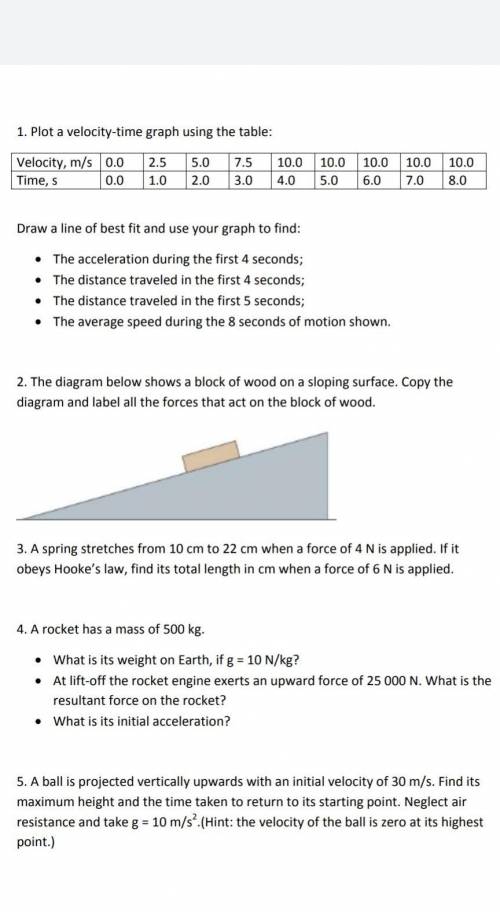
Physics, 02.12.2021 14:00, hallkayleel0lozgxtq
1. Plot a velocity-time graph using the table:
Velocity, m/s 0.0 2.5 5.0 7.5 10.0 10.0 10.0 10.0 10.0
Time, s 0.0 1.0 2.0 3.0 4.0 5.0 6.0 7.0 8.0
Draw a line of best fit and use your graph to find:
The acceleration during the first 4 seconds;
The distance traveled in the first 4 seconds;
The distance traveled in the first 5 seconds;
The average speed during the 8 seconds of motion shown.
2. The diagram below shows a block of wood on a sloping surface. Copy the
diagram and label all the forces that act on the block of wood.
3. A spring stretches from 10 cm to 22 cm when a force of 4 N is applied. If it
obeys Hooke’s law, find its total length in cm when a force of 6 N is applied.
4. A rocket has a mass of 500 kg.
What is its weight on Earth, if g = 10 N/kg?
At lift-off the rocket engine exerts an upward force of 25 000 N. What is the
resultant force on the rocket?
What is its initial acceleration?
5. A ball is projected vertically upwards with an initial velocity of 30 m/s. Find its
maximum height and the time taken to return to its starting point. Neglect air
resistance and take g = 10 m/s2
.(Hint: the velocity of the ball is zero at its highest point.
Please help me! I need need your help!


Answers: 1
Other questions on the subject: Physics

Physics, 21.06.2019 17:20, gymer630
American eels (anguilla rostrata) are freshwater fish with long, slender bodies that we can treat as uniform cylinders 1.0 m long and 10 cm in diameter. an eel compensates for its small jaw and teeth by holding onto prey with its mouth and then rapidly spinning its body around its long axis to tear off a piece of flesh. eels have been recorded to spin at up to 14 revolutions per second when feeding in this way. although this feeding method is costly in terms of energy, it allows the eel to feed on larger prey than it otherwise could. 1.a field researcher uses the slow-motion feature on her phones camera to shoot a video of an eel spinning at its maximum rate. the camera records at 120 frames per second. through what angle does the eel rotate from one frame to the next? 2. the eel is observed to spin at 14 spins per second clockwise, and 10 seconds later it is observed to spin at 8 spins per second counterclockwise. what is the magnitude of the eels average angular acceleration during this time? 3. the eel has a certain amount of rotational kinetic energy when spinning at 14 spins per second. if it swam in a straight line instead, about how fast would the eel have to swim to have the same amount of kinetic energy as when it is spinning? 4.a new species of eel is found to have the same mass but one-quarter the length and twice the diameter of the american eel. how does its moment of inertia for spinning around its long axis compare to that of the american eel?
Answers: 1

Physics, 22.06.2019 08:00, hartzpeyton136
5g of ammonium nitrate was dissolved in 60g of water in an insulated container. the temperature at the start of the reaction was 23.0°c and at the end it was 19.0°c. calculate the energy absorbed by the reaction.
Answers: 3

Physics, 22.06.2019 11:30, alupton4887
Arocket starts from rest and moves upward from the surface of the earth. for the first 10.0 s of its motion, the vertical acceleration of the rocket is given by ay = 12.80 m/s32t, where the +y-direction is upward. (a) what is the height of the rocket above the surface of the earth at t = 10.0 s? b) what is the speed of the rocket when it is 325 m above the surface of the earth?
Answers: 3
Do you know the correct answer?
1. Plot a velocity-time graph using the table:
Velocity, m/s 0.0 2.5 5.0 7.5 10.0 10.0 10.0 10.0 1...
Questions in other subjects:

Mathematics, 05.11.2020 16:40


Chemistry, 05.11.2020 16:40







English, 05.11.2020 16:40






